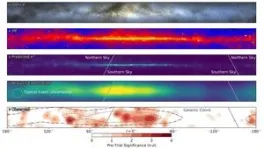(Press-News.org) For the first time, researchers have produced an image of the Milky Way using neutrinos, which were observed with the IceCube telescope in the Antarctic ice. The neutrino image suggests that cosmic ray interactions are more intense in the center of our galaxy than once thought. The results are published in an article in the journal Science.
For ages, the view of our Milky Way galaxy has inspired awe, visible with the naked eye as a hazy band of stars that stretches across the sky. Now IceCube researchers are able to see the Milky Way using neutrinos – tiny, ghostlike particles that fly freely through matter and space.
The neutrinos were detected using the IceCube Neutrino Observatory, a neutrino telescope built at the South Pole and monitoring 1 billion tons of the Antarctic ice for the rare neutrino interactions. Members of the IceCube Collaboration at Stockholm University and Uppsala University have been involved in the analysis of the data acquired during ten years of observations and in the interpretation of the results.
“Seeing our galaxy with neutrinos is something that we dreamed of, but which seemed out of reach for our project for many years to come,” says Chad Finley, associate professor at Stockholm University and one of the IceCube team members who worked closely on the paper. “What made this result possible today is the revolution in Machine Learning, allowing us to explore much deeper into our data than before.”
During the last century, astronomers began to study the Milky Way in all wavelengths of light, from radio waves to gamma rays. High-energy gamma rays in our galaxy are believed to be created mainly by the interaction of cosmic rays, high-energy protons and nuclei, with galactic gas and dust. This process should produce neutrinos as well. However, large uncertainties about the intensity of cosmic ray interactions in different parts of our galaxy made predictions for neutrinos a challenge.
The analysis method used for the latest results was originally developed in 2017 at Stockholm University by Jonathan Dumm, a postdoctoral researcher at the Oskar Klein Centre. “Jon realized that if the upper range of these neutrino predictions were correct, they might have been faintly detectable in the IceCube data we had at the time,” says Chad Finley.
To really map out the neutrino contours of the Milky Way, however, it was expected that many more years of data-taking would be needed. While the IceCube Observatory records billions of events each year, only a very tiny fraction (one in one-hundred million recorded events) is due to neutrinos from space. Identifying these neutrino events is a difficult computational task. Thanks to the development of new computing techniques called Deep Neural Networks, it has become possible to identify these neutrino events with 20 times higher efficiency than before.
“High-energy neutrinos provide us with a wonderful new tool for studying the Milky Way. The next step is to identify the neutrino sources, potentially the sites for galactic cosmic ray acceleration” says Olga Botner, senior professor at Uppsala University. “If realized, the planned IceCube-Gen2 would enable a deeper yet exploration of the galactic plane, allowing us to distinguish between various source distributions and models for cosmic ray propagation.”
More information
The article “Observation of High-Energy Neutrinos from the Galactic Plane” is published in the scientific journal Science.
Facts on IceCube
The IceCube Collaboration is an international group of over 350 scientists based at 58 institutions around the world. Stockholm University and Uppsala University are two of the founding members of the IceCube project. The IceCube Neutrino Observatory is supported by the National Science Foundation, as well as the Swedish Research Council (Vetenskapsrådet) and national funding agencies in other countries. See https://icecube.wisc.edu/
Contact
Chad Finley, associate professor at the Department of Physics, Stockholm University, cfinley@fysik.su.se, Phone +46-702295361
Olga Botner, professor at the Department of Physics and Astronomy, Uppsala University, olga.botner@physics.uu.se, Phone +46-184713876
END
The first neutrino image of our galaxy
2023-06-29
ELSE PRESS RELEASES FROM THIS DATE:
DNA organization in real-time
2023-06-29
Performing cutting-edge science requires thinking outside the box and bringing together different scientific disciplines. Sometimes this even means being in the right place at the right time. For David Brückner, postdoctoral researcher and NOMIS fellow at ISTA, all the above-mentioned things came into effect as he attended an on-campus lecture by Professor Thomas Gregor from Princeton University. Inspired by the talk, Brückner reached out with an idea: to physically interpret the specific data sets Gregor presented. Now, the results of their collaboration are published ...
JDR Clinical & Translational Research receives first ever Impact Factor™
2023-06-29
Alexandria, VA – The International Association for Dental, Oral, and Craniofacial Research (IADR) and the American Association for Dental, Oral, and Craniofacial Research (AADOCR) announced today the JDR Clinical & Translational Research (JDR CTR) has received its first Journal Impact Factor™.
JDR CTR has earned a Journal Impact Factor of 3.0, with an Eigenfactor™ of 0.00148, an Immediacy Index of 0.5, and 786 total citations in 2022. This represents a significant achievement and a huge milestone in JDR CTR’s history, which was launched in 2016.
“JDR CTR’s new Impact Factor marks the culmination of years of commitment ...
Journal of Dental Research announces New Impact Factor™
2023-06-29
Alexandria, VA – The International Association for Dental, Oral, and Craniofacial Research and American Association for Dental, Oral, and Craniofacial Research announced the Journal of Dental Research (JDR) 2-Year Journal Impact Factor™ is now 7.6, ranking it #3 of 91 journals in the “Dentistry, Oral Surgery & Medicine” category.
The JDR 5-year Journal Impact Factor™ is also 7.6, with an Immediacy Index of 1.1 and an article Influence score of 1.638. The JDR once again ranked #1 of 91 journals in total citations, with a total of 25,849 in 2022, and ranked #3 in Eigenfactor with a score of 0.01345.
The 2-year Journal Impact Factor™ is defined ...
NASA’s Webb identifies the earliest strands of the cosmic web
2023-06-29
Galaxies are not scattered randomly across the universe. They gather together not only into clusters, but into vast interconnected filamentary structures with gigantic barren voids in between. This “cosmic web” started out tenuous and became more distinct over time as gravity drew matter together.
Astronomers using NASA’s James Webb Space Telescope have discovered a thread-like arrangement of 10 galaxies that existed just 830 million years after the big bang. The 3 million light-year-long structure is anchored by a luminous quasar – a galaxy with an active, supermassive black hole at ...
Improvement to CRISPR gene editing could make it more effective
2023-06-29
DURHAM, N.C. – CRISPR gene editing is a breakthrough that has been used to treat diseases such as sickle cell anemia, leukemia and genetic disorders, but it has challenges that limit its broad utility.
Identifying the root of those issues led a research team at Duke Health to find an improved approach to gene editing that expands its functionality.
In work appearing online June 29 in the journal Cell Chemical Biology, the researchers lay out a new way to identify diverse CRISPR RNA variants that can specifically home in on challenging areas of DNA to target for editing. The new approach opens up more of the genome for editing, ...
Water fasts can help you lose weight, but you might gain it back quickly
2023-06-29
Water fasts — where people consume nothing but water for several days — might help you lose weight, but it’s unclear how long you’ll keep it off, according to research from the University of Illinois Chicago. And the other metabolic benefits of water fasts, such as lower blood pressure and improved cholesterol, seem to disappear soon after the fast ends, the researchers found.
However, there do not appear to be any serious adverse effects for those who do a water fast or a similar kind of fast where people consume a very small number of calories a day, said Krista Varady, professor of kinesiology and nutrition, who led the research, ...
Energy insecurity is an underappreciated social and environmental determinant of health
2023-06-29
In light of climate change and the impending transition to clean energy, many long-standing programs to address energy insecurity need to be refreshed. A new paper published online in the journal Health Affairs provides growing documentation of the connections between energy insecurity and poor health. The paper, by Diana Hernandez, PhD, associate professor of sociomedical sciences at Columbia University Mailman School of Public Health, also offers an overview of current policy initiatives and discusses ways that current policies can be improved upon.
The average U.S. household allocates 3.1 percent of its income to energy expenses but for low-income households, ...
Current developments in nutrition debuts strong with its first impact factor
2023-06-29
Rockville, MD – The latest journal impact factors and rankings reflect the high-quality research that is published each year by the American Society for Nutrition (ASN).
Scopus recently ranked Advances in Nutrition the number one journal in the Nutrition and Dietetics field. The Society’s newest journal, Current Developments in Nutrition, surpassed expectations with an excellent inaugural impact factor of 4.8 confirming its promising future.
“I am delighted to receive such a superb first impact factor,” stated Jack Odle, PhD, William Neal Reynolds Distinguished Professor at North Carolina State University and Editor-in-Chief of Current ...
CHEST releases clinical practice guideline on antithrombotic therapy in arterial thrombosis and thromboembolism in COVID-19
2023-06-29
Glenview, Illinois – The American College of Chest Physicians® (CHEST) recently released a new clinical guideline on antithrombotic therapy in arterial thrombosis andthromboembolism in COVID-19. Published in the journal CHEST®, the guideline contains 11 evidence-based recommendations to improve risk-evaluation and to assist in determining the course of treatment.
While there are guidelines for the management of COVID-19-related coagulopathy for venous thromboembolism (VTE), a recent large cohort study showed ...
UTHSC College of Pharmacy rises to No. 6 in research funding from National Institutes of Health
2023-06-29
The College of Pharmacy at the University of Tennessee Health Science Center is now ranked No. 6 in annual research funding from the National Institutes of Health, according to a new listing published by the American Association of Colleges of Pharmacy of its approximately 140 member institutions.
“The ranking of No. 6 in NIH funding for federal fiscal year 2022 is external validation for the UTHSC College of Pharmacy’s standing as one of the leading institutions in research among the 142 U.S. pharmacy schools,” said Bernd Meibohm, ...





